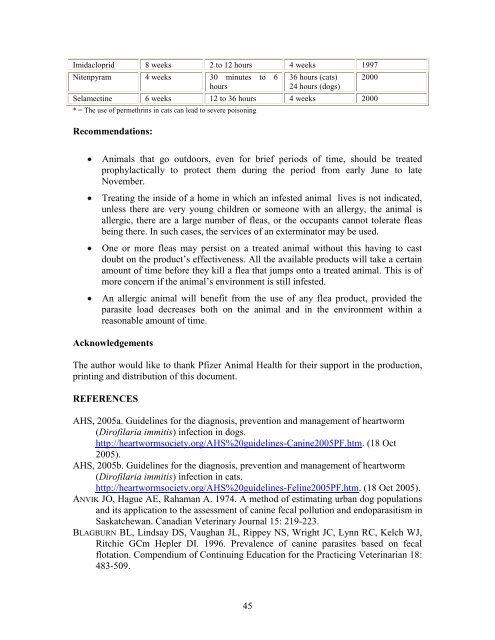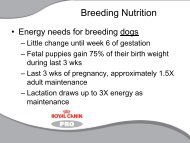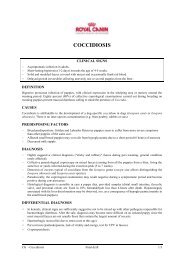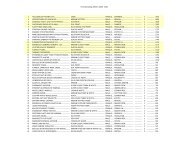Guide to Preventing Parasites.pdf - Royal Canin Canada
Guide to Preventing Parasites.pdf - Royal Canin Canada
Guide to Preventing Parasites.pdf - Royal Canin Canada
Create successful ePaper yourself
Turn your PDF publications into a flip-book with our unique Google optimized e-Paper software.
Imidacloprid 8 weeks 2 <strong>to</strong> 12 hours 4 weeks 1997<br />
Nitenpyram 4 weeks 30 minutes <strong>to</strong> 6<br />
hours<br />
45<br />
36 hours (cats)<br />
24 hours (dogs)<br />
2000<br />
Selamectine 6 weeks 12 <strong>to</strong> 36 hours 4 weeks 2000<br />
* = The use of permethrins in cats can lead <strong>to</strong> severe poisoning<br />
Recommendations:<br />
Animals that go outdoors, even for brief periods of time, should be treated<br />
prophylactically <strong>to</strong> protect them during the period from early June <strong>to</strong> late<br />
November.<br />
Treating the inside of a home in which an infested animal lives is not indicated,<br />
unless there are very young children or someone with an allergy, the animal is<br />
allergic, there are a large number of fleas, or the occupants cannot <strong>to</strong>lerate fleas<br />
being there. In such cases, the services of an extermina<strong>to</strong>r may be used.<br />
One or more fleas may persist on a treated animal without this having <strong>to</strong> cast<br />
doubt on the product’s effectiveness. All the available products will take a certain<br />
amount of time before they kill a flea that jumps on<strong>to</strong> a treated animal. This is of<br />
more concern if the animal’s environment is still infested.<br />
An allergic animal will benefit from the use of any flea product, provided the<br />
parasite load decreases both on the animal and in the environment within a<br />
reasonable amount of time.<br />
Acknowledgements<br />
The author would like <strong>to</strong> thank Pfizer Animal Health for their support in the production,<br />
printing and distribution of this document.<br />
REFERENCES<br />
AHS, 2005a. <strong>Guide</strong>lines for the diagnosis, prevention and management of heartworm<br />
(Dirofilaria immitis) infection in dogs.<br />
http://heartwormsociety.org/AHS%20guidelines-<strong>Canin</strong>e2005PF.htm. (18 Oct<br />
2005).<br />
AHS, 2005b. <strong>Guide</strong>lines for the diagnosis, prevention and management of heartworm<br />
(Dirofilaria immitis) infection in cats.<br />
http://heartwormsociety.org/AHS%20guidelines-Feline2005PF.htm. (18 Oct 2005).<br />
ANVIK JO, Hague AE, Rahaman A. 1974. A method of estimating urban dog populations<br />
and its application <strong>to</strong> the assessment of canine fecal pollution and endoparasitism in<br />
Saskatchewan. Canadian Veterinary Journal 15: 219-223.<br />
BLAGBURN BL, Lindsay DS, Vaughan JL, Rippey NS, Wright JC, Lynn RC, Kelch WJ,<br />
Ritchie GCm Hepler DI. 1996. Prevalence of canine parasites based on fecal<br />
flotation. Compendium of Continuing Education for the Practicing Veterinarian 18:<br />
483-509.







